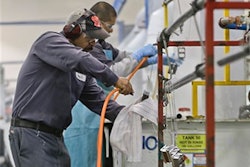WASHINGTON (AP) — U.S. factories received fewer orders in October, as aircraft demand fell and businesses cut back on computers. The decline suggests companies were hesitant to invest during the 16-day partial government shutdown.
Factory orders dropped 0.9 percent in October, the Commerce Department said Thursday. That followed a 1.8 percent increase in September.
A big reason for the decline in October was a steep drop in orders for aircraft.
But core capital goods, which are a proxy for business investment, dropped 0.6 percent, the second straight decline. Economists watch this category closely because it excludes volatile orders for aircraft and defense equipment.
Much of the decline in that category came from a drop in demand for computers. Demand picked up for primary metals, household appliances and oil and gas field machinery.
All of these are long-lasting goods. The government estimated demand for these products last week and revised their figures in the factory orders report on Thursday.
The report also includes orders for non-durable goods, such as food, chemicals and paper. Those orders fell 0.2 percent and have declined for the past three months.
The government's data have conflicted with other reports that show manufacturing is on an upswing.
The Institute for Supply Management, a trade group, said Monday that factory activity grew last month at the fastest pace in 2 ½ years. It was also the sixth straight month that the survey showed improvement.
Strong auto sales have pushed up demand for steel and other metals, while the rebound in home construction after a summer lull should translate into demand for furniture and appliances.
Factory output rose for the third straight month in October, according to the Federal Reserve, driven higher by greater production of primary metals and furniture. Overseas demand for many goods has also risen as Europe has climbed out of recession, Japan is growing faster and China's economy has slowed but is still growing at a healthy pace.
Manufacturers are also hiring more workers, typically a sign of confidence in the market. Factories have added 38,000 jobs from August through October, according to the government's employment reports.
November was likely another strong month, according to the ISM data and private payroll provider ADP. On Wednesday, ADP said factories added 18,000 jobs last month.
The government releases its November employment report on Friday.


















